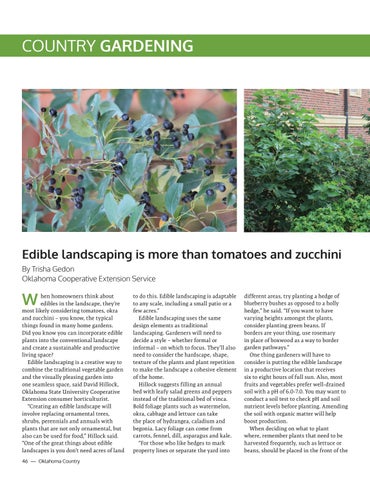COUNTRY GARDENING
Edible landscaping is more than tomatoes and zucchini By Trisha Gedon Oklahoma Cooperative Extension Service hen homeowners think about edibles in the landscape, they’re most likely considering tomatoes, okra and zucchini – you know, the typical things found in many home gardens. Did you know you can incorporate edible plants into the conventional landscape and create a sustainable and productive living space? Edible landscaping is a creative way to combine the traditional vegetable garden and the visually pleasing garden into one seamless space, said David Hillock, Oklahoma State University Cooperative Extension consumer horticulturist. “Creating an edible landscape will involve replacing ornamental trees, shrubs, perennials and annuals with plants that are not only ornamental, but also can be used for food,” Hillock said. “One of the great things about edible landscapes is you don’t need acres of land 46 — Oklahoma Country
to do this. Edible landscaping is adaptable to any scale, including a small patio or a few acres.” Edible landscaping uses the same design elements as traditional landscaping. Gardeners will need to decide a style – whether formal or informal – on which to focus. They’ll also need to consider the hardscape, shape, texture of the plants and plant repetition to make the landscape a cohesive element of the home. Hillock suggests filling an annual bed with leafy salad greens and peppers instead of the traditional bed of vinca. Bold foliage plants such as watermelon, okra, cabbage and lettuce can take the place of hydrangea, caladium and begonia. Lacy foliage can come from carrots, fennel, dill, asparagus and kale. “For those who like hedges to mark property lines or separate the yard into
different areas, try planting a hedge of blueberry bushes as opposed to a holly hedge,” he said. “If you want to have varying heights amongst the plants, consider planting green beans. If borders are your thing, use rosemary in place of boxwood as a way to border garden pathways.” One thing gardeners will have to consider is putting the edible landscape in a productive location that receives six to eight hours of full sun. Also, most fruits and vegetables prefer well-drained soil with a pH of 6.0-7.0. You may want to conduct a soil test to check pH and soil nutrient levels before planting. Amending the soil with organic matter will help boost production. When deciding on what to plant where, remember plants that need to be harvested frequently, such as lettuce or beans, should be placed in the front of the
